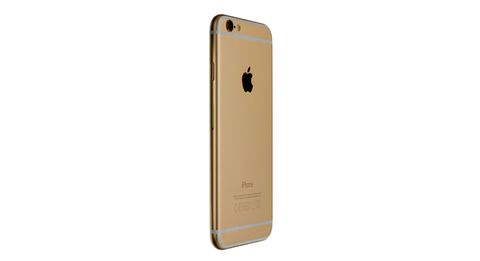If there’s one thing to be said about Apple, it’s that the company dances to its own tune. It certainly doesn’t bother with the petty business of seeing what everybody else is doing.
For its latest smartphone, the Apple iPhone 6, that means there is no Full HD screen, even when key rivals have adopted Quad HD. There is no 16-megapixel camera with laser focusing and image stabilisation, and no hi-res audio support.
You might have written your own wishlist containing all the possible tech out there, but Apple couldn’t care less what you think.
Why? Because Apple focuses on performance over specs, and it’s a strategy that has served it extremely well. What its products lack in grunt, they make up for in finesse.
The Apple iPhone 6’s performance and user experience is hard to beat, which makes it easily one of the best smartphones around.
MORE: Awards 2014 - Best smartphones
Design

The iPhone has had a significant makeover (the first in four years) ditching the squared edges that launched with the iPhone 4 – returning to a more rounded design, instead.
Its smooth, aluminium framework blends seamlessly into its new-size screen (more on that later), curving around to meet each other in a way that makes it irresistible to roll in your hand, over and over, when you first hold it.
The iPhone 6 feels unimaginably slim too: shaving 0.7mm from its predecessor’s size, to measure a lithe 6.9mm; its tapered edges accentuate this, too. It’s a masterclass in premium smartphone design, that's mirrored by Samsung with its Galaxy S6.
It weighs in at 129g, somewhat heavier than its predecessor (112g), but it feels pretty much the same in hand.
You’ll find the plastic accents remain at the top and bottom of the phone’s back panel, a necessary compromise for any aluminium-bodied phone, to ensure mobile phone signal is sent and received efficiently.
The camera lens also protrudes from the framework slightly, though we haven’t found this to be a problem in use or think that it takes anything away from the overall slickness of its design.
To help with its slightly larger size, Apple has moved the power button to the right-hand side – a clever move, it helps make locking and unlocking the phone much easier, something HTC failed to sort on its (M8) model.
Everything else remains much the same – the volume buttons and silent switch stay on the left-hand side, while the headphone jack sits along the bottom, next to a single speaker grille.
Screen
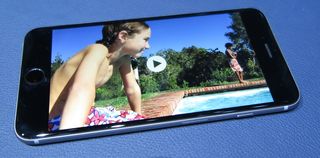
Yes, Apple has started to make larger phones after years of ignoring the market trend and sticking with screens 4in or under. The iPhone 6’s screen measures 4.7in, which is still below average but a notable increase on its predecessors.
The screen has a resolution of just 1334x750, which on paper is a little low, especially with Full HD 1080p screens being the norm and Quad HD on the rise. But resolution isn’t everything and the iPhone’s pixels work very hard to hold off the competition.
Of course its larger sibling, the 5.5in iPhone 6 Plus, answers the demand for a larger screen and the iPhone 6 is intended to sit somewhere in the middle – not alienating fans of its 4in display, while still acknowledging the trend for larger screens.
We think the size works well. The increase is noticeable – use the iPhone 6 for a few minutes and go back to the 5 or 5s and you’ll feel the difference immediately.
It feels like a good compromise, and while still smaller than most of 2014’s big hitters, it doesn’t feel too small to enjoy video or gaming on, for example. The added size also allows for an extra row of icons on your screen – up from five to six.
This year, Apple has finally gone full HD, but only on the screen of the iPhone 6 Plus, leaving the iPhone 6 with a pixel count that remains the same at 326ppi.
It’s easy to be a little disappointed – 2013’s HTC One had a 4.7in display and managed a full HD resolution – and yet, once you start to compare it to some of its full HD competition, you realise just how well it fares.
Edges are accurately drawn and fine details are nicely etched. Colours are on the cool side of neutral, but there’s vibrancy where needed.
Across the colour spectrum, tones are convincing. Contrast is strong, too – the blacks aren’t AMOLED dark but they’re impressively deep, while whites are strong without being dazzling.
It offers vibrancy where it’s needed, but most importantly, there’s believability across the spectrum in a way few can match.
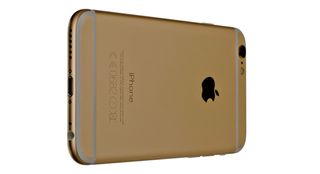
This helps ensure a wide tonal spread, particularly in hard to render colours like green and red, producing a subtler, more realistic picture than most of its competitors.
It’s also been adapted so it works better when viewed with polarised sunglasses, losing the green tinge that plagued the 5s.
The likes of the Samsung Galaxy S6 and LG G4 have the edge when it comes to outright detail and contrast, but the Apple won’t attract many complaints on its own.
Text looks sharp and easy to read when browsing the internet using Safari, though some apps at the time of testing are yet to be optimised for the new resolution, resulting in a slight “zoomed in” effect when launching, to avoid letterboxing.
This means text looks softer and ever so slightly less defined, but this is something that individual app developers will need to address, rather than Apple itself.
Finally, a nifty addition to help those struggling with the jump from 4in to 4.7in is ‘Reachability’.
A quick double tap on the home button will bring the icons from the top of the screen to within a thumb’s reach away, making one-handed use much easier.
Audio

Audio has always been one of Apple’s greatest strengths and the iPhone 6 maintains that tradition. The absence of hi-res audio support is disappointing, but that’s easy to ignore when the CD-quality 44.1kHz performance is this good.
The rich, full-bodied character we know and love remains, but with a little extra clarity.
It’s as enthusiastic as it is engaging, jumping into life with a play through of Run the Jewels’ self-titled track; the bouncing bassline getting your foot tapping.
The treble steers clear of ever sounding hard or harsh, while the midrange is focused and expressive, providing a well-balanced listen that works with all genres and is never tiring to listen to.
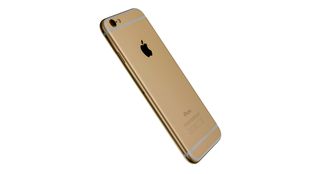
The standard resolution sound beats any other audio performance we’ve heard from 2014’s smartphones, and with the majority of people using their smartphone for streaming and nothing higher than CD-quality rips, it’s this standard-res performance that’s the most important to get right. Apple has nailed it once again.
It is still bundled with Apple’s Earpods, and though they’re better than the original white buds, we’d still recommend an upgrade to something like AKG’s Y50s to make the most of your music.
The mono speaker on the bottom of the handset remains, but with the grille just on the right-hand side now.
The iPhone 6 can’t compete with the likes of the HTC One (M8)’s front-facing stereo speakers, but it is louder and clearer compared to its predecessor.
It’ll get you by for a short burst, but more involved movie or music sessions will be best experienced via headphones.
Camera
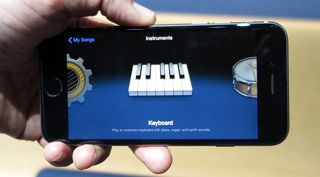
As with the rest of the device, the camera isn't top-spec like the LG or Samsung.
The iPhone 6's camera features a new sensor, though in terms of megapixels, it still packs the same 8MP as before.
That might seem pretty paltry when compared to the 20MP offered by some Android manufacturers, but the results speak for themselves.
In good light, images are sharp, with minimal noise, superb detail retrieval and excellent colour reproduction. Autofocus is quicker and more intuitive than before; improved face detection on both front and rear cameras mean that snapping is quicker and sharper than ever.
The HDR (high dynamic range) mode is quicker too, meaning the processing delay found on the iPhone 5s is practically non-existent.
Manual exposure control is a new addition, accessed by tapping the screen and swiping up or down to adjust how bright or dark you want the photo.
The iPhone usually gets it spot on itself, but this gives you the ability to manipulate it quickly and easily, should you wish. The front-facing snapper sees more improvements join its new face-detecting capabilities, including a new f/2.2 lens to let in more light, so things look sharper and less noisy than before.
Features previously only available on the rear-facing camera also feature here too, including burst mode and timer, ensuring you get those selfies just right.
Low-light photography sees an expected drop in detail, but the iPhone still captures a well-balanced image that is largely free from grain.
For when the light really does drop too low, the ‘True Tone’ flash works well at ensuring subjects aren’t bleached out and that believable skin tones are retained.

Video remains at 1080p, though it also has a few new tricks up its sleeve, namely a time-lapse mode, and an even slower slo-mo, now offered at 120fps and 240fps.
Both might seem a bit gimmicky, but used in the right situations can actually be very effective indeed.
Although it doesn’t feature the optical image stabilisation of the iPhone 6 Plus, we did notice the iPhone 6 captured smoother, sharper video compared with that of the 5s.
Specifications
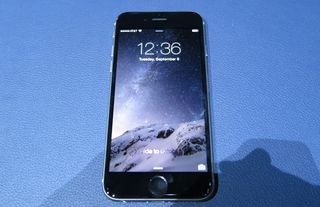
As we’ve come to expect from yearly iPhone updates, the iPhone 6 features a boosted processor in the shape of Apple’s own A8 chip. Apple never confirms specifics, but it would appear that it’s a dual-core chip, supported by around 1GB RAM.
On paper, it might seem underpowered compared to some of Android’s powerhouses, but in use, it’s up there with the best. Why? The fact that Apple designs its own chip for its own requirements – knowing exactly what it’s dealing with and how it will react to various things, such as multi-tasking.
Many Android phones use third-party chips, which have to prepare themselves for all eventualities – different skins, different screen sizes, different functionality, the list goes on.
There’s no right or wrong way, but how the iPhone performs reminds us that the proof is always in the testing and not on the spec list.
Considering it’s now packing more processing power than the likes of the iPad Air, you can imagine that it’s a hugely smooth, lag-free experience.
Flicking between browser windows and different apps serves up no problems whatsoever, while 3D gaming with something like Asphalt 8: Airbourne looks superb.
Apple’s new ‘Metal’ technology is at play here, which aims to give developers the tools to bring console-quality gaming to iOS devices. It promises quicker load times, more responsive gameplay and the ability for more detailed environments, as beautifully demonstrated in the free-to-download (and ultimately ‘Metal’ show-off app) Zen Garden.
We’re looking forward to seeing more games incorporating this in the future. The battery life on the iPhone 6 has been improved, if only rather humbly.
As ever, it completely depends on how heavy a user you are. But placing ourselves firmly in the heavy-user category, we’re finding an extra few hours of battery life.
Lighter users will manage a full day without issue; however daily charging is not a thing of the past with the iPhone just yet.
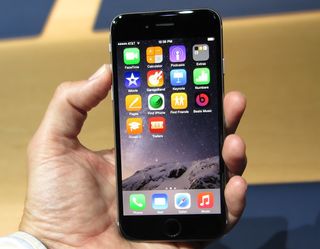
At least now you can see which apps are sapping all of your battery life – a feature that has been available on Android for some time – allowing you to adjust accordingly.
Storage options have had a tweak compared with previous iPhone iterations, offering 16GB, 64GB and the new 128GB, doing away with 32GB completely.
The good news is the 64GB version is around the same price, SIM-free, as the 32GB iPhone 5s was previously, meaning you’re now getting more for your money.
Of course this storage is non-expandable so it’s worth considering carefully what you think you’ll need.
We’d expect 64GB would suit most, though 128GB is a nice addition for the power users among you.
MORE: What is Apple CarPlay? Apps, cars, features
Features
The iPhone 6 comes with iOS 8 running out of the box – not looking a whole lot different to iOS 7 – but it brings a number of usability tweaks to make the iPhone experience better than ever.
This includes the ability to change keyboards, a feature that’s been available on Android for some time, giving access to the popular alternatives like SwiftKey and Swype.
The stock iPhone keyboard has also had a tweak too, adding predictive text, though you can switch back to autocorrect in settings if you want.
Other additions include new mail commands for easier organising of emails, a smoother shared experience between iPhone, iPad and Mac, notifications that offer the opportunity for a “quick reply” without leaving the app you’re in and a new Health app, which can pull in the data from various fitness apps to give you an in-depth look at your activity levels throughout the day.
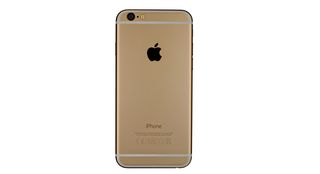
All these tweaks are iOS 8 updates and available across older devices too, but the iPhone 6 still has some of its own additions as well, like a new NFC chip.
Unfortunately, it’s a little useless to UK users at the moment, with Apple confirming it is saved solely for the Apple Pay scheme – currently only running in the US – and cannot be used for pairing to audio devices and the like.
Apple Pay will allow for you to pay for things using your phone and fingerprint (via Touch ID) at participating retailers – we’ll have to wait for its launch here to judge its efficacy.
Verdict
Draw up a list of everything you want from a smartphone and it’s unlikely that Apple will grant many of your wishes.
We’d love to see a removable battery, or expandable memory, or hi-res audio, but Apple doesn’t swing that way. Rather than spreading itself thin, the company does the key things really well.
If you already buy into Apple’s way of doing things, you’ll be very happy indeed.
MORE: The evolution of the Apple iPhone
